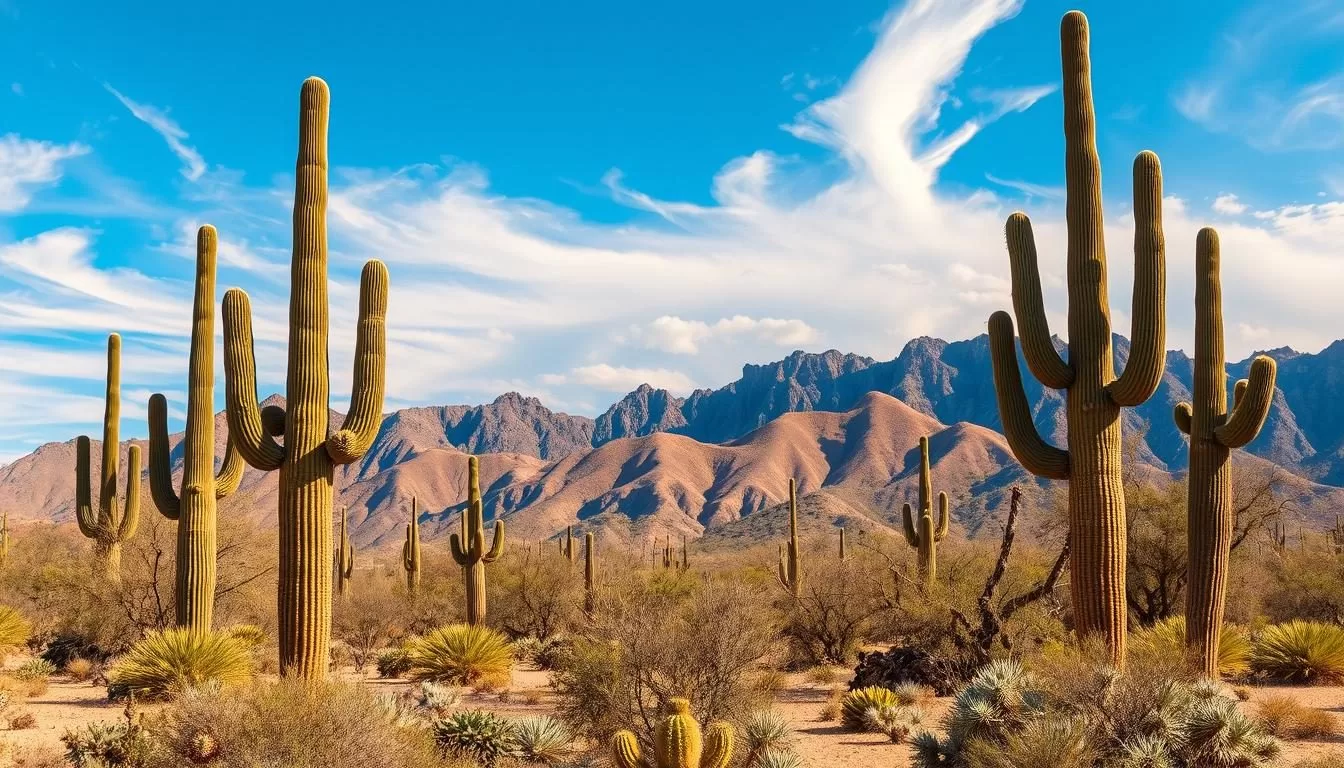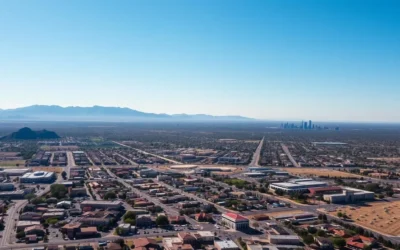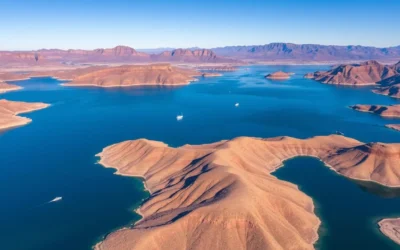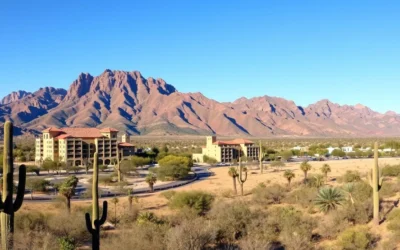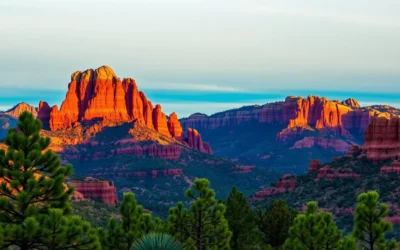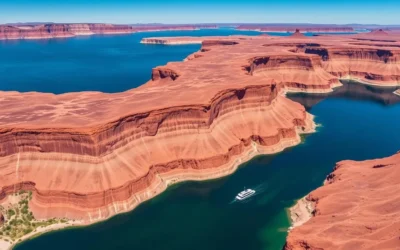✓ Accommodations✓ Flights✓ Rental Cars✓ Tours & Activities
Welcome to a desert wonderland in southern Arizona, home to the iconic saguaro cactus, the largest cactus in the United States.
This unique national park is an easy destination to visit, with scenic drives and short walks among towering cacti. You can explore the highlights in just half a day, but with more time, you can tour the entire park, go on a day hike, or camp in the backcountry.
Whether you’re looking for a quick adventure or an extended exploration, this guide will help you make the most of your trip to Saguaro National Park.
Discovering the Iconic Saguaro National Park
Saguaro National Park, home to the giant saguaro cactus, offers an unparalleled opportunity to experience the beauty and harsh conditions of the Sonoran Desert. As you visit this unique national park, you’ll be surrounded by the majestic saguaro cactus, a symbol of the American West.
![]()
The Majestic Saguaro Cactus
The saguaro cactus (Carnegiea gigantea) is a large, tree-sized cactus native to the Sonoran Desert. It has a relatively long lifespan of up to 250 years. Its beautiful white, waxy flower, which blooms from late May to July, is the Arizona state flower and a favorite treat for the diverse animal populations that call Saguaro National Park home.
Two Distinct Districts: East and West
Saguaro National Park is divided into two distinct districts: the East District (Rincon Mountain) and the West District. Each district offers unique landscapes and experiences, from scenic drives to hiking trails, allowing visitors to explore the diverse places within the park.
What Makes This Park Special
Unlike most national parks that protect mountains, canyons, or forests, Saguaro preserves a unique desert ecosystem adapted to some of the harshest conditions in North America. The park serves as a living laboratory where you can witness the remarkable adaptations of desert plants and animals that have evolved to thrive in extreme heat and limited water. The biodiversity within the park is surprising, with numerous species of birds, mammals, reptiles, and insects that have developed fascinating strategies for desert survival.
Saguaro National Park, Arizona: Best Things to Do – Top Picks in the West District
The West District of Saguaro National Park is a treasure trove of natural beauty and adventure, offering a variety of experiences that cater to different interests and ages. As you explore this remarkable area, you’ll discover unique landscapes, diverse wildlife, and fascinating insights into the Sonoran Desert ecosystem.
Bajada Loop Drive

Bajada Loop Drive is a scenic route that takes you through some of the most breathtaking landscapes in Saguaro National Park’s West District. This drive offers a unique perspective on the park’s diverse flora and fauna, making it an ideal activity for those looking to experience the natural beauty of the Sonoran Desert.
Valley View Overlook Trail
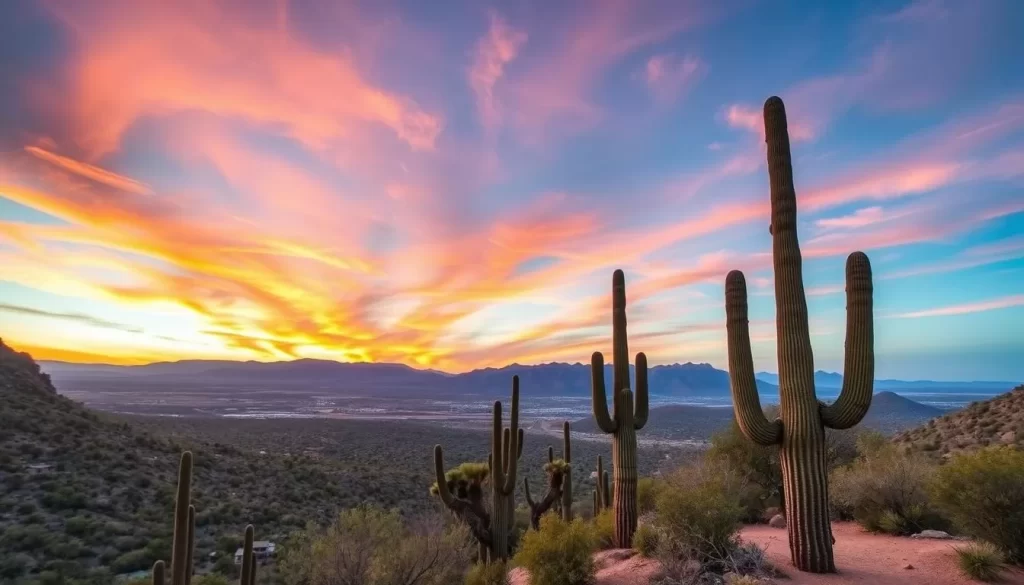
The Valley View Overlook Trail is a must-visit destination for hikers and nature enthusiasts. This trail provides panoramic views of the surrounding landscape, offering a glimpse into the vast and varied beauty of Saguaro National Park. As you hike, you’ll be treated to stunning vistas that showcase the park’s unique geological features.
Signal Hill Petroglyphs
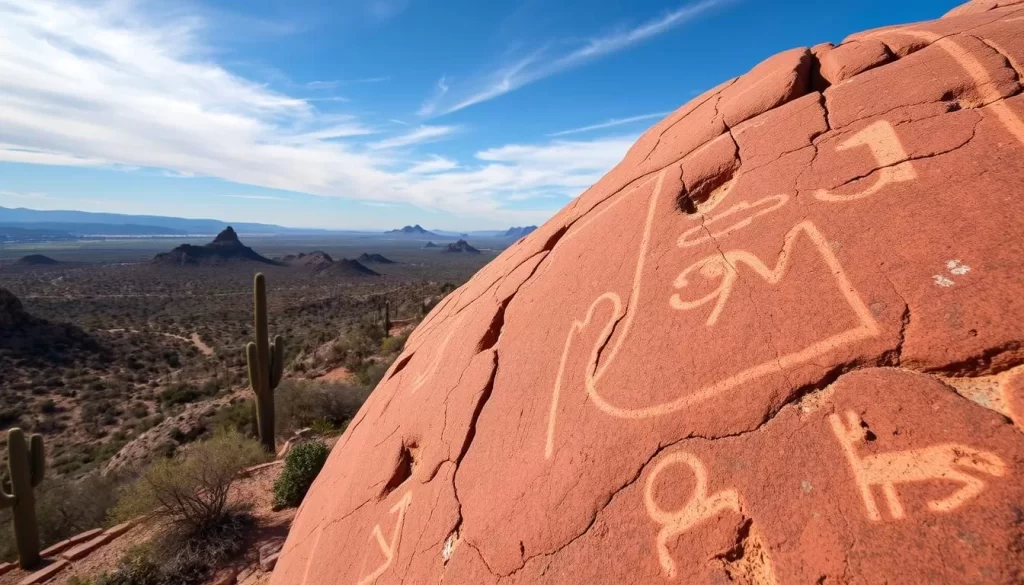
Signal Hill Petroglyphs is a fascinating site that provides a glimpse into the cultural heritage of the region. The petroglyphs found here are a testament to the rich history of human presence in the area, making it a compelling visit for those interested in archaeology and cultural history. As you explore this site, you’ll gain a deeper understanding of the people who once called this land home.
Desert Discovery Nature Trail

The Desert Discovery Nature Trail is a 0.5-mile self-guided loop that offers an ideal introduction to the Sonoran Desert ecosystem, especially for first-time visitors to Saguaro National Park. With its accessible, paved pathway and informative signs, this trail is perfect for visitors of all ages and abilities. You’ll learn about the various desert plants, including the iconic saguaro cactus, and their adaptations to the harsh desert environment.
- The trail features interpretive signs that identify various desert plants and explain their remarkable adaptations for survival.
- Located just off Kinney Road in Saguaro West, this trail is conveniently situated near the Red Hills Visitor Center.
- The paved, relatively flat pathway makes this trail accessible for visitors of all ages and abilities.
- Along the trail, you’ll learn to identify various cacti species and desert trees, enhancing your understanding of the desert ecosystem.
Must-See Attractions in the East District (Rincon Mountain)
The East District of Saguaro National Park, encompassing the Rincon Mountain area, is a treasure trove of natural wonders waiting to be discovered. This district offers a diverse range of landscapes and attractions that are sure to captivate any visitor.
Cactus Forest Scenic Loop Drive
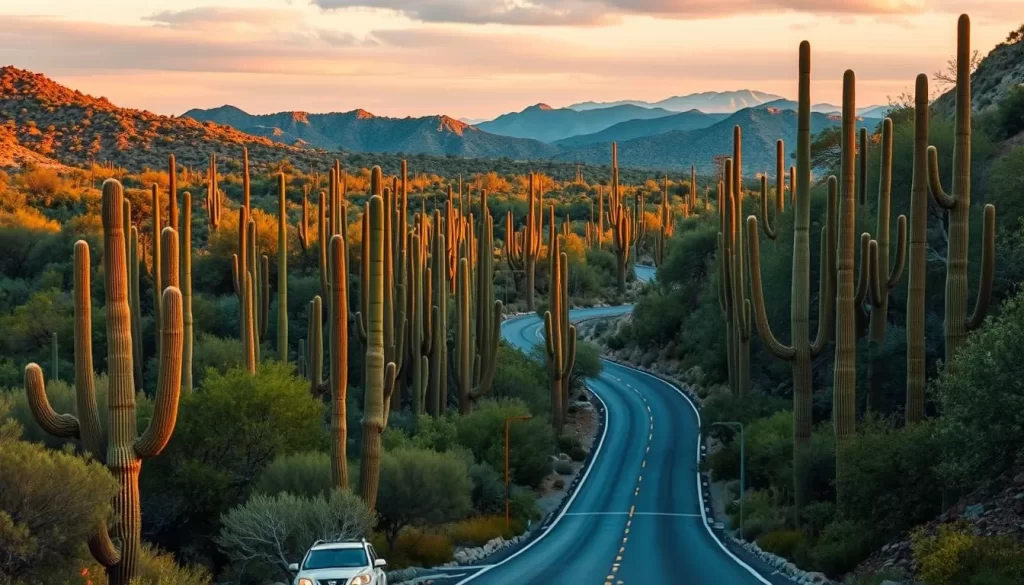
The Cactus Forest Scenic Loop Drive is a scenic 8-mile loop that takes you through a stunning forest of saguaro cacti. This drive is particularly beautiful during sunrise when the soft light enhances the dramatic silhouette of the cacti against the sky.
Mica View Trail
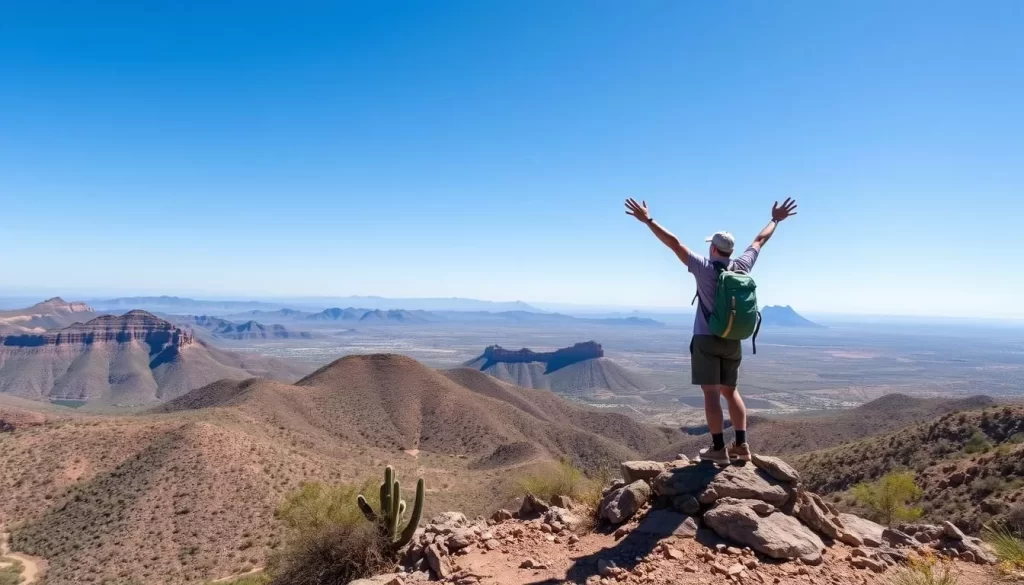
The Mica View Trail is a moderate 3.5-mile round-trip hike that rewards hikers with panoramic views of the surrounding landscape. On a clear day, you can see the Tucson Mountains and the city skyline.
Desert Ecology Trail

The Desert Ecology Trail is a 0.25-mile loop that offers insights into the unique ecosystem of the Sonoran Desert. Interpretive signs along the trail explain the various plants and their adaptations to the desert environment.
Javelina Rocks at Sunset
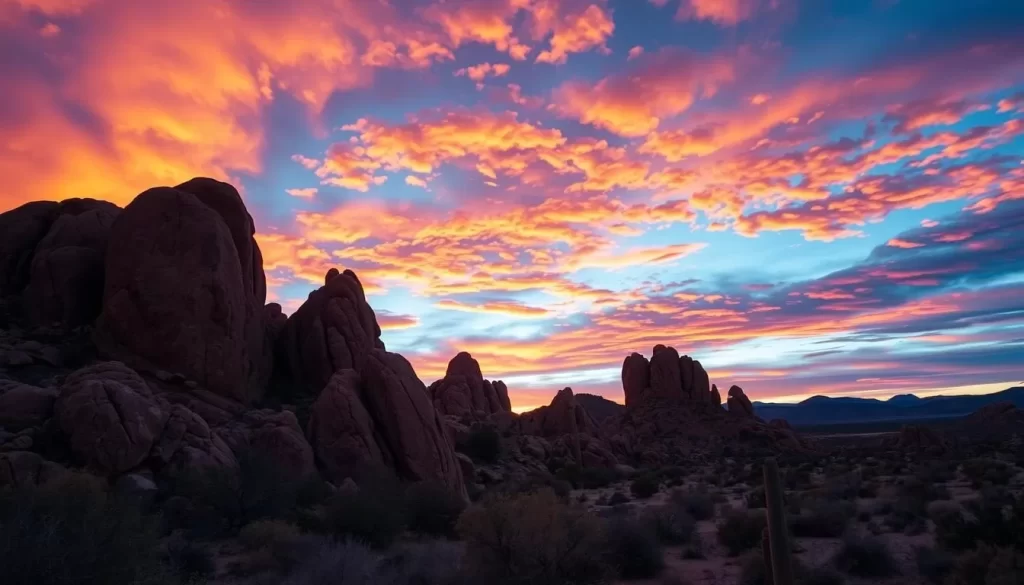
Javelina Rocks offers one of the most spectacular sunset viewing locations in Saguaro East. The elevated position provides panoramic views across the saguaro forest toward the Tucson Mountains. As the sun sets, the changing light creates a magical effect on the landscape, with the saguaros silhouetted against the colorful sky.
The area around Javelina Rocks features interesting geological formations and a slightly different plant community than other parts of the park. After sunset, this area offers excellent opportunities for stargazing due to the minimal light pollution in the Rincon Mountain District.
Planning Your Visit to Saguaro National Park
To ensure a memorable experience, it’s essential to plan your visit to Saguaro National Park carefully. Whether you’re heading to the Tucson Mountain District in the west or the Rincon Mountain District in the east, preparation is key.
Best Time to Visit
The best time to visit Saguaro National Park is from October to April, when the weather is mild and comfortable for hiking and exploring. During these months, the temperatures are pleasant, making it ideal for visiting the visitor center and enjoying the park’s scenic drives.
Entrance Fees and Hours
Saguaro National Park is open 365 days a year. The entrance fee is $35 per vehicle for a private vehicle pass, valid for 7 days. You can also purchase an annual pass for $70. The visitor center hours vary depending on the district you are visiting.
Where to Stay Near the Park
Since there are no lodging facilities within Saguaro National Park itself, you’ll need to find accommodations in nearby Tucson. For the Tucson Mountain District, consider staying at the JW Marriott Tucson Starr Pass Resort and Spa, which offers upscale amenities. For the Rincon Mountain District, Cactus Cove Bed and Breakfast Inn is a charming option.

For budget-friendly options, Hotel McCoy is centrally located and offers reasonable access to both districts. If you prefer camping, Gilbert Ray Campground is a great choice near Saguaro West.
Essential Tips for an Unforgettable Saguaro Experience
To make the most of your trip to Saguaro National Park, consider these essential tips for an unforgettable experience. Whether you’re hiking, wildlife watching, or photography enthusiast, being prepared is key to enjoying all that the park has to offer.
Safety in the Desert
When exploring the park, it’s crucial to stay safe in the desert environment. Be sure to bring plenty of water, wear sun protection, and watch for hazards like rattlesnakes and spiky cactus spines.
Wildlife Encounters
Saguaro National Park is home to diverse wildlife. Keep a safe distance from animals like Gila monsters and coyotes, and never feed them. Enjoy observing from afar and respect their natural habitat.
Photography Tips
Capturing the beauty of saguaro cacti requires some planning. The golden hours of early morning and late afternoon provide the best light. Use a wide-angle lens to capture expansive landscapes, and consider a macro lens for detailed shots of cactus spines and desert flowers. Don’t forget a polarizing filter to reduce glare and enhance the desert sky. For night photography, head to the Rincon Mountain District for darker skies.
![]()
Conclusion: The Timeless Beauty of the Sonoran Desert
The Sonoran Desert’s timeless beauty, as preserved within Saguaro National Park, offers a truly unforgettable experience. Saguaro National Park is not just a collection of iconic cacti, but a complete desert ecosystem that has evolved over thousands of years.
Whether you spend a few hours or several days exploring the park, the image of majestic saguaros standing sentinel across the desert will remain one of your most memorable national park experiences. The contrasting experiences of the two districts offer complementary perspectives on the Sonoran Desert.
As you conclude your visit or trip, consider how your perception of desert ecosystems has changed. The preservation of this unique area ensures that future generations will have the opportunity to experience the same sense of wonder that visitors have felt for years. Your adventure in this special place will inspire a deeper appreciation for the Sonoran Desert’s beauty.
The above is subject to change.
Check back often to TRAVEL.COM for the latest travel tips and deals.
